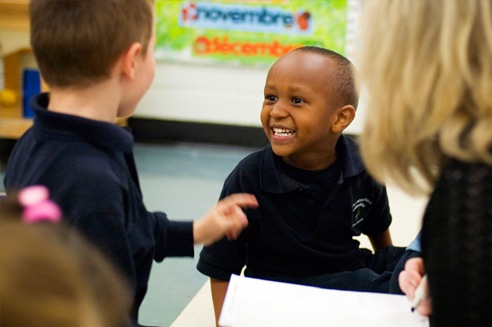
What role can schools play?
SCENARIO : Student 1 has recently joined your classroom in the context of a school that is ethnoculturally homogenous. The student is a newcomer to Canada, and has just arrived from an African country. When Student 1 enters the room, all the other students stare at him. During recess, the students avoid him and whisper about him. When you have a small group project, you notice that the students exclude him, and you overhear Student 2 mutter something quietly to Student 1. She says: “Get away from me, you’re dirty”.
You’ve made an important decision to promote cooperation and collaboration in an effort to prevent racism and xenophobia among students.
This kind of situation often occurs in schools. It may seem easier to deal with it ourselves than to take the time to engage students in identifying and implementing bullying prevention strategies.
When an adult takes control of the situation, they may miss important opportunities to promote the values and attitudes associated with equity and inclusive education. Students need to develop their own moral code and learn to accept differences and to reach out and include others. It may be useful to take advantage of this learning opportunity in the short term in order to discuss the problem and develop strategies with the students.
Some important elements are missing from this option: Student 1 has obtained no support and Student 2 has not been held responsible for her comments.
2You immediately interrupt the bullying behaviour and meet with Students 1 and 2 individually. You provide support to Student 1 and together you explore strategies to increase his sense of safety. You encourage Student 2 to reflect upon her behaviour and to explore strategies for prevention and reparation.
Student 1 receives support and Student 2 is held responsible for her comments.
Students 1 and 2 perceive you as an adult resource person who stands up against bullying and discriminatory behaviour.
The witnesses have learned nothing, nor have any other members of the school community. No message has been sent affirming that inclusion is an integral part of the school’s code of conduct and that this kind of behaviour is unacceptable. There is a strong likelihood that this kind of negative attitude will be perpetuated.
3You identify that there is a school-wide problem and you decide to develop strategies to interrupt the bullying and engender real and ongoing change. You approach students, colleagues and your principal and together you undertake to revise and update the school’s code of conduct and all policies and procedures aimed at ensuring respect for differences, preventing bullying and addressing issues related to equity and inclusive education.
In order to bring about real and lasting change in the school culture, it is crucial to systemic support of this long-term goal. This can be achieved through the development of clear and coherent policies and procedures, as well as a wide range of other innovative measures to interrupt and prevent bullying, racism and other forms of inequity and discrimination.
All members of the schools community have a role to play in the process leading to change. Through their participation, they receive a clear message about the kinds of values the school is seeking to uphold.
Student 1 has obtained no support and Student 2 has not been held responsible for her comments.
✓Explanation of the recommended response.
Recommended response and explanation:The first answer offers a short-term though incomplete strategy, while the second and third answers are both recommended responses, though neither is comprehensive or complete. Both contain important components of an effective response to a bullying situation involving racism (or another form of discrimination). The second answer is a crucial first step since it ensures effective intervention and interrupts the bullying in the short term, though witnesses have not been engaged or supported to become allies. On the other hand, long term and effective bullying prevention and promotion of equity and inclusion (such as anti-racism and other forms of discrimination) involve strategies aimed at involving all members of the school community in changing the school culture to one where respect for differences and rights is firmly embedded. Answer 3 provides an example of such a strategy, since coherent policies and procedures are key to supporting all other activities and intervention.
Note:For information about intervening with all parties involved in a bullying situation, see module 7. For information about the development of a bullying prevention plan and promoting equity and inclusion, see Modules 9 and 10.
